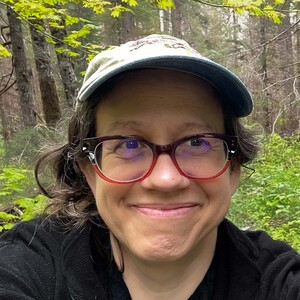
Leah Wilson
Eugene, Oregon
Place-specific visual artist interweaving art with physical engagement with the environment, keen observation, and a curiosity toward scientific research
Message
Leah Wilson is painter, sculptor, and writer known for her time-intensive art that explore the rhythms and patterns of specific landscapes and they way they change over time. An initial artist residency at the HJ Andrews Experimental Forest in the Oregon Cascades introduced her to ecologists working on long-term studies and field research. Attracted by the enduring focus of inquiry into a specific place, she is a lifetime artist-in-residence at the Andrews Forest. This is a place that has inspired many of her projects, stemming from extensive conversations on site with scientists about interpreting our changing ecosystems through the lens of extended research.
Wilson’s art interweaves her passion for whitewater kayaking and outdoor adventures, ecology, and environmental issues. At the age of 18 she became a river guide and instructor leading her to create a pivotal project influenced by the environmental decision-making processes of scientists, resource managers, and special interest groups during the Federal Energy Relicensing Commission’s assessment of her local watershed. This experience and decades of wilderness exploration form the backbone that continues to inform her creative process.
Wilson’s artwork has been exhibited at galleries throughout the West Coast and her work is in public and private collections including the Percent for Art Collection of the State of Oregon. She has participated in collaborative projects in including Oregon Origins Project and Playa’s inaugural Wildfire + Water project. When she is not making art or in the field with an ecologist, Leah can often be found outside greeting the sun as it rises, running trails through a forest, bouncing down a rapid, or climbing a very old and tall tree. Wilson lives in Eugene, Oregon and teaches art at Oregon State University.
Statement
I make paintings, drawings, and layered low-relief wall sculptures from my physical experiences in landscapes. I return to the same places month ofter month and year after year to deepen my understanding and relationship, desiring to foster a feeling that I belong there, even in places that feel remote and desolate. I am drawn to places that flow and change. Rivers and creeks are often where I begin, but the more time I spend in the places, less pronounced flows draw my attention: earth flows, old lava flows, the flow of water within trees, and the flow of time. Unexpected patterns, connections, relationships, and rhythms catch my attention. I explore these slowly and reflectively as I create my art, eager to strengthen my ability to perceive. I want to see what I could not see before, feel what I could not feel before. Often I venture into forests and waterways with ecologists who see the land and water much differently than I do. Scientists spark new questions and curiosity in me and reveal distinctions in the land that I had not previously noticed. Curiosity and inquiry are through lines in my art. Through the wonder this ignites I not only better understand and know the specific places I work from, but wonder eventually provides access to grappling with inscrutable concepts like climate change and deep time, making them feel more tangible.
I revel in painting as my primary medium, riding its long tail of history to engage with contemporary environmental questions and observations. My process is time-intensive and contemplative. I make my paint by hand and source some pigments from the places I explore in my art. The physical properties of the pigments and paint, and its relationship to my subjects and the form and techniques of my art, take on more importance to me as digital technology and AI become more pervasive in daily life. Every pigment has its own personality connected to its origin, interweaving physical properties of color and place into my art. The scale of my art is often similar to that of a human body - it is not small and intimate, but also not large and overwhelming. Using scale, I want the land to relate to ourselves. However, the scale of the subjects in my art is ambiguous and disorienting, pointing to the wonder and curiosity that ignite me. The images could be microscopic, they could depict an aerial landscape that spans many square miles, or anywhere in between. Shapes and forms can appear abstract. Upon further investigation, the shapes start to reveal discernible features in the landscape and the scale begins to be understood: roads, agricultural irrigation pivots, and levies can be seen. Contours of lakes, water currents, and specific geological features arise. As the abstraction takes shape and associations form tangible connections, stories about the land and water are explored.